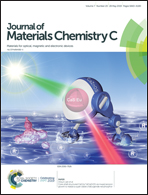Epitaxial growth via anti-solvent-induced deposition towards a highly efficient and stable Mn4+ doped fluoride red phosphor for application in warm WLEDs†
Abstract
The poor moisture-resistant property of the commercial narrow band red-emitting K2SiF6:Mn4+ phosphor restricts its practical application in high performance warm WLEDs. Herein, we report epitaxial growth via simple ethanol-induced deposition to enhance the luminescence and moisture resistance of K2SiF6:Mn4+. Specifically, an appropriate amount of ethanol at the end of the synthesis leads to epitaxial growth of a K2SiF6:Mn4+ shell. The resultant K2SiF6:Mn4+@K2SiF6:Mn4+ presents higher photoluminescence intensity due to a high Mn4+ critical concentration in the K2SiF6:Mn4+ epitaxial shell. Furthermore, the epitaxial growth of the K2SiF6 shell on K2SiF6:Mn4+ is designed to conquer the moisture resistance. As expected, the formed K2SiF6:Mn4+@K2SiF6 retains 82% of the initial emission intensity after being immersed in water for 4 h and 90% after being exposed to high temperature and humidity (85 °C, 85%) for 10 days. By employing K2SiF6:Mn4+@K2SiF6 as a red phosphor, a packaged white LED exhibits excellent performance with a CRI of 96.5, a CCT of 2879 K and a luminous efficacy of 119.74 lm W−1. More importantly, this fabricated WLED device retains high luminous efficacy and undergoes minor chromatic coordinate changes when aged at high temperature and humidity (85 °C, 85%). Therefore, these findings not only illustrate the effect of ethanol addition on the photoluminescence intensity of Mn4+ doped phosphors in the synthesis process, but also provide a facile strategy to improve the moisture resistance of K2SiF6:Mn4+ for warm WLEDs in the future.



 Please wait while we load your content...
Please wait while we load your content...